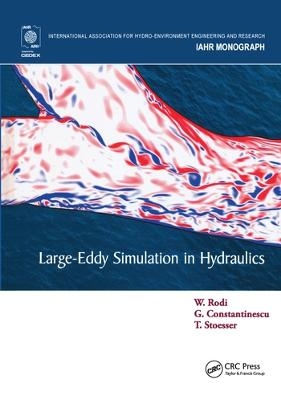
Large-Eddy Simulation in Hydraulics
Seiten
2020
CRC Press (Verlag)
978-0-367-57638-7 (ISBN)
CRC Press (Verlag)
978-0-367-57638-7 (ISBN)
An introduction to the Large-Eddy-Simulation (LES) method, geared primarily toward hydraulic and environmental engineers, the book covers special features of flows in water bodies and summarizes the experience gained with LES for calculating such flows.
Large-Eddy Simulation (LES), which is an advanced eddy-resolving method for calculating turbulent flows, is used increasingly in Computational Fluid Dynamics, also for solving hydraulics and environmental flow problems. The method has generally great potential and is particularly suited for problems dominated by large-scale turbulent structures. This book gives an introduction to the LES method specially geared for hydraulic and environmental engineers. Compared with existing books on LES it is less theoretically and mathematically demanding and hence easier to follow, and it covers special features of flows in water bodies and summarizes the experience gained with LES for calculating such flows.
The book was written primarily as an introduction to LES for hydraulic and environmental engineers, but it will also be very useful as an entry to the subject of LES for researchers and students in all fields of fluids engineering. The applications part will further be useful to researchers interested in the physics of flows governed by the dynamics of coherent structures.
Large-Eddy Simulation (LES), which is an advanced eddy-resolving method for calculating turbulent flows, is used increasingly in Computational Fluid Dynamics, also for solving hydraulics and environmental flow problems. The method has generally great potential and is particularly suited for problems dominated by large-scale turbulent structures. This book gives an introduction to the LES method specially geared for hydraulic and environmental engineers. Compared with existing books on LES it is less theoretically and mathematically demanding and hence easier to follow, and it covers special features of flows in water bodies and summarizes the experience gained with LES for calculating such flows.
The book was written primarily as an introduction to LES for hydraulic and environmental engineers, but it will also be very useful as an entry to the subject of LES for researchers and students in all fields of fluids engineering. The applications part will further be useful to researchers interested in the physics of flows governed by the dynamics of coherent structures.
Wolfgang Rodi, George Constantinescu, Thorsten Stoesser
1. Introduction 2. Basic methodology of LES 3. Subgrid-scale (SGS) models 4. Numerical methods 5. Implicit LES (ILES) 6. Boundary and initial conditions 7. Hybrid RANS-LES methods 8. Eduction of turbulence structures 9. Application examples of LES in hydraulics Appendix A – Introduction to tensor notation
| Erscheinungsdatum | 01.07.2020 |
|---|---|
| Reihe/Serie | IAHR Monographs |
| Verlagsort | London |
| Sprache | englisch |
| Maße | 170 x 245 mm |
| Gewicht | 453 g |
| Themenwelt | Mathematik / Informatik ► Mathematik ► Angewandte Mathematik |
| Naturwissenschaften ► Geowissenschaften ► Hydrologie / Ozeanografie | |
| Naturwissenschaften ► Physik / Astronomie ► Strömungsmechanik | |
| Technik ► Bauwesen | |
| Technik ► Umwelttechnik / Biotechnologie | |
| ISBN-10 | 0-367-57638-4 / 0367576384 |
| ISBN-13 | 978-0-367-57638-7 / 9780367576387 |
| Zustand | Neuware |
| Informationen gemäß Produktsicherheitsverordnung (GPSR) | |
| Haben Sie eine Frage zum Produkt? |
Mehr entdecken
aus dem Bereich
aus dem Bereich
Buch | Softcover (2024)
Springer Vieweg (Verlag)
37,99 €
Buch | Softcover (2024)
Springer Vieweg (Verlag)
44,99 €
für Ingenieure und Naturwissenschaftler
Buch | Softcover (2024)
Springer Vieweg (Verlag)
34,99 €


